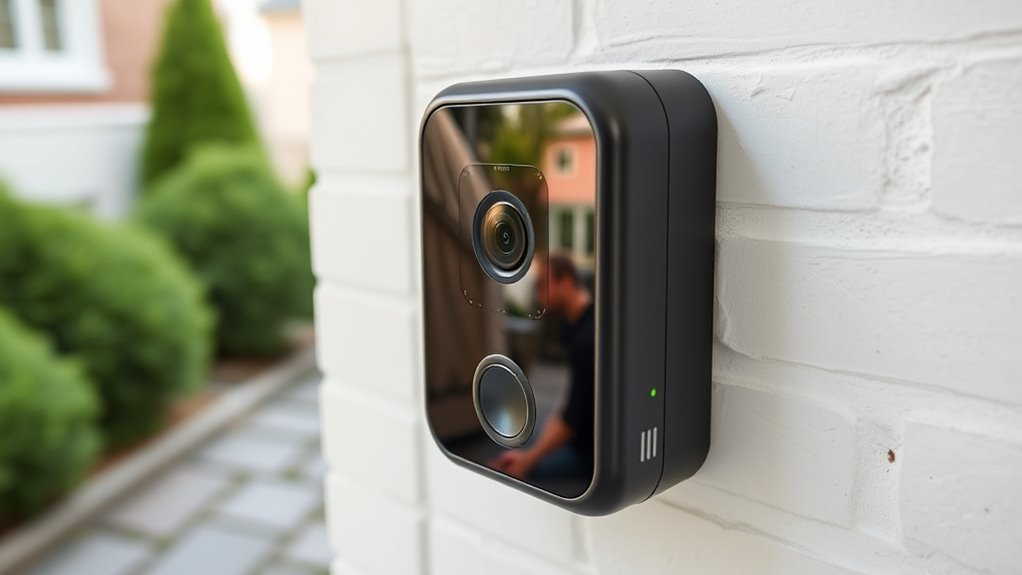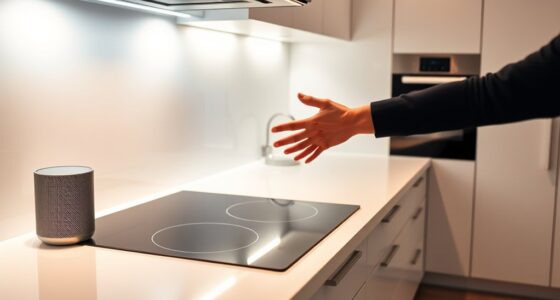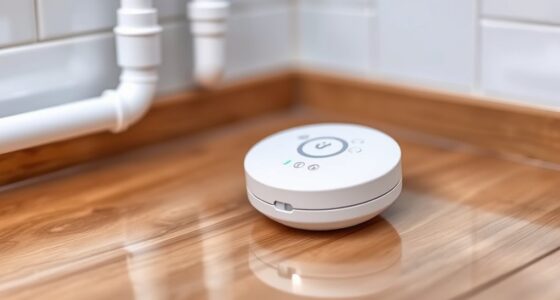Facial recognition doorbells can boost your home security and offer convenience by identifying visitors instantly. However, they also raise privacy and safety concerns, such as storing sensitive biometric data and potential hacking risks. Many devices collect images of neighbors or passersby, which can infringe on privacy and lead to unauthorized surveillance. Understanding the security measures and policies behind these systems is essential to protect your privacy—if you want to learn more, there’s important information you should consider.
Key Takeaways
- Facial recognition doorbells collect and store biometric data, raising privacy concerns if data security measures are inadequate.
- Users must review and consent to data collection policies, including potential sharing or selling of biometric information.
- Data breaches or hacking can expose sensitive facial data, risking identity theft and privacy violations.
- Recording footage of neighbors or passersby may infringe on their privacy rights without proper consent.
- Manufacturers should implement strong encryption and transparent policies to balance security benefits with privacy protections.

Facial recognition doorbells are transforming home security by allowing you to identify visitors instantly. You can see who’s at your door without opening it, and in many cases, get detailed information about familiar faces or even unknown visitors. But with this advanced technology comes important concerns about data security and user consent. As you adopt these devices, it’s vital to understand how your personal data is being collected, stored, and used. Facial recognition systems capture and analyze images of faces, creating biometric data that’s highly sensitive. If this data isn’t protected properly, it could fall into the wrong hands, leading to privacy breaches or identity theft. That’s why manufacturers and service providers need to prioritize robust data security measures, including encryption and secure storage. You should also be aware of how your data could be shared or sold, and what policies are in place to protect your information.
Another key aspect to contemplate is user consent. When you install a facial recognition doorbell, you’re often asked to agree to certain terms and conditions, which may include data collection and sharing practices. It’s important to read these carefully so you understand what you’re agreeing to. In some cases, the device might analyze not only visitors’ faces but also record footage of your property, which could include neighbors or passersby. If the system uses data from multiple sources, it raises questions about whether everyone’s consent has been obtained. As a user, you should have control over your own data, and that includes being able to opt out or delete stored information if you choose. Additionally, understanding the data security measures implemented by manufacturers can help you assess the risks involved.
Beyond individual privacy, there are broader societal concerns. Facial recognition technologies have the potential for misuse or abuse, especially if data security measures are weak. Hacks or leaks could expose sensitive biometric information, and unauthorized surveillance could infringe on privacy rights. It’s your right to demand transparency from manufacturers about how they handle data and whether they comply with privacy laws. You should also stay informed about regulations in your area, as some jurisdictions have enacted laws to restrict or regulate facial recognition use. Ultimately, while facial recognition doorbells can boost your home security, you must weigh these benefits against the privacy risks. Being proactive about understanding data security measures and insisting on clear user consent policies helps guarantee that your privacy remains protected. This way, you can enjoy the convenience of smarter security without compromising your personal privacy or safety.
Frequently Asked Questions
How Do Facial Recognition Doorbells Store My Data?
Facial recognition doorbells store your data through cloud storage, where it’s protected by data encryption. When someone approaches, the device captures your facial features and uploads this information securely online. The encryption ensures that only authorized systems can access your data, keeping it safe from hackers. You should review the company’s privacy policy to understand how they handle and retain your data, guaranteeing your privacy stays protected.
Can Hackers Access Facial Recognition Doorbell Footage?
Yes, hackers can access facial recognition doorbell footage through access risks like weak passwords or outdated software. Data breaches may expose your footage if security measures aren’t robust enough. To protect yourself, make certain your device has updates, use complex passwords, and enable two-factor authentication. Staying vigilant reduces the chances of unauthorized access, helping safeguard your privacy and security against potential cyber threats.
Are There Laws Regulating Facial Recognition Technology at Home?
Is there a legal shield protecting your privacy? While some states have enacted laws regulating facial recognition technology at home, extensive federal legislation remains scarce. Privacy legislation varies widely, and legal restrictions aim to curb misuse and protect personal data. You should stay informed, as laws are evolving. Ultimately, understanding your rights helps you navigate the delicate balance between security and privacy in a world increasingly driven by facial recognition technology.
What Measures Protect My Privacy From Third-Party Access?
To protect your privacy from third-party access, make certain your doorbell uses strong encryption protocols, which safeguard your data during transmission and storage. Additionally, always give explicit user consent before sharing facial recognition data with third parties. Regularly review privacy settings, keep firmware updated, and choose devices that prioritize user control and transparency. These steps help maintain your privacy and prevent unauthorized access to your facial recognition information.
How Accurate Is Facial Recognition in Different Lighting Conditions?
Facial recognition accuracy can vary markedly with lighting challenges and environmental factors. In well-lit conditions, your doorbell performs better, capturing clear images for accurate identification. However, in low light or harsh shadows, accuracy drops because the system struggles to distinguish features. Weather, like rain or fog, also impacts performance by obscuring faces. To improve reliability, consider installing the device in areas with consistent lighting and minimal environmental interference.
Conclusion
As you install a facial recognition doorbell, it’s funny how privacy concerns often pop up just when you’re about to enjoy added security. Sometimes, a simple doorbell can unexpectedly open a can of worms—raising questions about data misuse and safety. While it seems like a coincidence that technology designed for convenience can also bring risks, staying informed helps you make smarter choices. After all, the right balance keeps your home secure without sacrificing your privacy.









